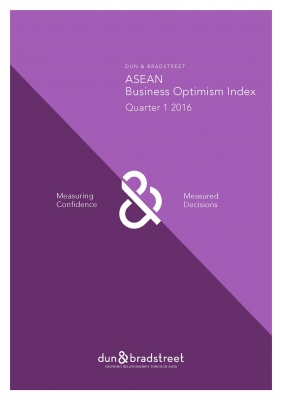
ASEAN Business Optimism Index: Quarter 1 2016
Published: January 2016The ASEAN Business Optimism Index is published quarterly by Dun & Bradstreet. It is the first and only business confidence index for the ASEAN economic bloc, comprising six countries namely Indonesia, Malaysia, Philippines, Singapore, Thailand and Vietnam – which collectively represent more than 95% of the region’s GDP output. Survey respondents are asked about their quarterly outlook on six key areas, such as volume of sales, net profit, selling price, new orders, inventory level and employment.
In this issue:
- Indonesia – Hands on Deck for a Better Outlook
- Malaysia – Too Early for Signs of Green Shoots?
- Philippines – Spring Fever for Filipino Businesses
- Singapore – Chips Stay Down for Manufacturing
- Thailand – Economic Stimulus Starts to Bear Fruit
- Vietnam – Fast-Track Growth Takes a Pit Stop
The ASEAN Business Optimism Index for Quarter 1 2016 is published by Dun & Bradstreet. It is the first and only business confidence index for the ASEAN economic bloc, comprising six countries namely Indonesia, Malaysia, Philippines, Singapore, Thailand and Vietnam – which collectively represent more than 95% of the region’s GDP output. Released quarterly, it measures the pulse of the business community and is one of the most effective ways to track how the business community perceives the business environment, and where they think it is going. Over time, this quarterly survey has emerged as a leading indicator of turning points in economic activity in countries which it is published.
For the purpose of conducting the survey, a sample is randomly selected from Dun & Bradstreet database, consisting of companies belonging to the following sectors including Agriculture, Construction, Electric, Finance, Manufacturing, Mining, Services, Transportation, and Wholesalers. All the respondents in the survey are asked six standard questions regarding their expectations as to whether the following critical parameters pertaining to their respective companies will register an increase, decline or show no change in the ensuing quarter as compared to the same quarter in the prior year: Volume of Sales, Net Profits, Selling Prices, New Orders, Inventory Levels, and Employees. The individual indices are then calculated by subtracting the percentage of respondents expecting decreases from those expecting increases. Unless otherwise stated, increases and decreases in indices represent changes from the previous quarter.

